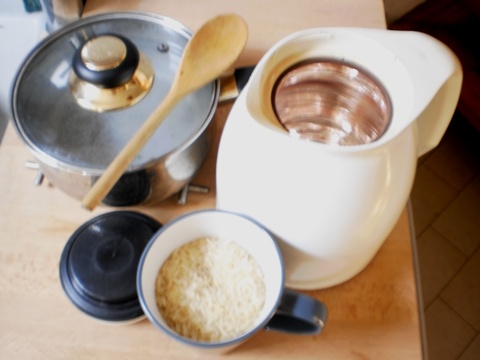In English it’s also called "fireless cooker" or "heat retention cooker". If you want, you can save fuel by subsequent cooking dishes in a hay box: one with hay (or sleeping bag, (Wonderbag),...) insulated box, widely used in the war. No fire, no smoke.. In addition to an insulating layer, a reflective layer is also useful, so that radiant heat is captured too.
Cook the dishes one sixth of the normal cooking time, start counting from the moment the content thoroughly cooks.
 Bring the pan then as soon as possible into the waiting haybox and close it. Let the dish over 2 X the normal cooking time in the hay coffin. So you can cook rice or pasta in a thermos. It works great, with only advantages. I have one with a large opening, it once stood on a coffee maker. Easy to fill, to empty and to wash and clean.
Bring the pan then as soon as possible into the waiting haybox and close it. Let the dish over 2 X the normal cooking time in the hay coffin. So you can cook rice or pasta in a thermos. It works great, with only advantages. I have one with a large opening, it once stood on a coffee maker. Easy to fill, to empty and to wash and clean.
I put a portion of rice or pasta in the thermos. I boil water (half a liter for 4/5th mug of rice), pour it in and twist the cap on. Shake to mix and to avoid clumping. And after 20 minutes (pasta), or 2 hours -it remains hot- it is ready. I must not stay at the fire and use much less energy. It is never burnt. You have to experiment a bit and keep an eye on the time to not overcook. Also the 2nd and 3rd portion stays warm long. It is very easy to pour off. And if you figure the proportions you not even have to throw away cooking water with more nutrients (also nice in the soup), everything is absorbed.
The rice I used sometimes to simmer again (with herbs, greens, mushrooms or some meat) to get him tasty, cooked and hot.
(To cook rice take about 1.5 volume of water per volume of rice (from 1/4 to more than 2x as much).
Ensure that the temperature of food remains higher than 60 degrees. Below there is a risk of bacterial growth. Avoid risks: just cook five minutes before serving, especially in meat dishes.
I also tried to cook eggs this way. 3 eggs removed from the refrigerator and let chambréd (taking room temperature) a few hours. Cooked largely half a liter of water. Eggs in the thermos. Boiling water on it. Thermos close. And only the next morning revealed. The water was still hot. The eggs as well. And hard-boiled. If you prefer to have them soft, about 10 minutes will be enough I guess. Experiment somewhat for yourself. Pretty nice : you wake up and boiled eggs are warm waiting for you.
Another similar use is the tea cozy and egg warmer to keep tea or eggs warm.
To keep a dish warm sometimes also a dome (Fr.: cloche), tagine or papillote (aluminum foil) are used.
The Scottish physicist James Dewar made a bottle with a vacuum between a double wall to save chemicals. His glassblower Reinhold Burger founded Thermos GmbH in 1904 and sold ’thermos bottles’.
Lacking thermos with a large opening you can also use a double-walled ice bucket with lid. If that can endure boiling water at least! Best is to warm it in advance with hot water.
One of the best tips to save energy: heat or cook no more water than you need.
How does a thermos know a drink has to stay cold or hot?
‘Look, I bought a thermos. What you do in hot, stays hot, and what you do in cold stays cold’ ‘Seems convenient.. What did you put in it?’ ‘A pint of soup and two ice creams.’
